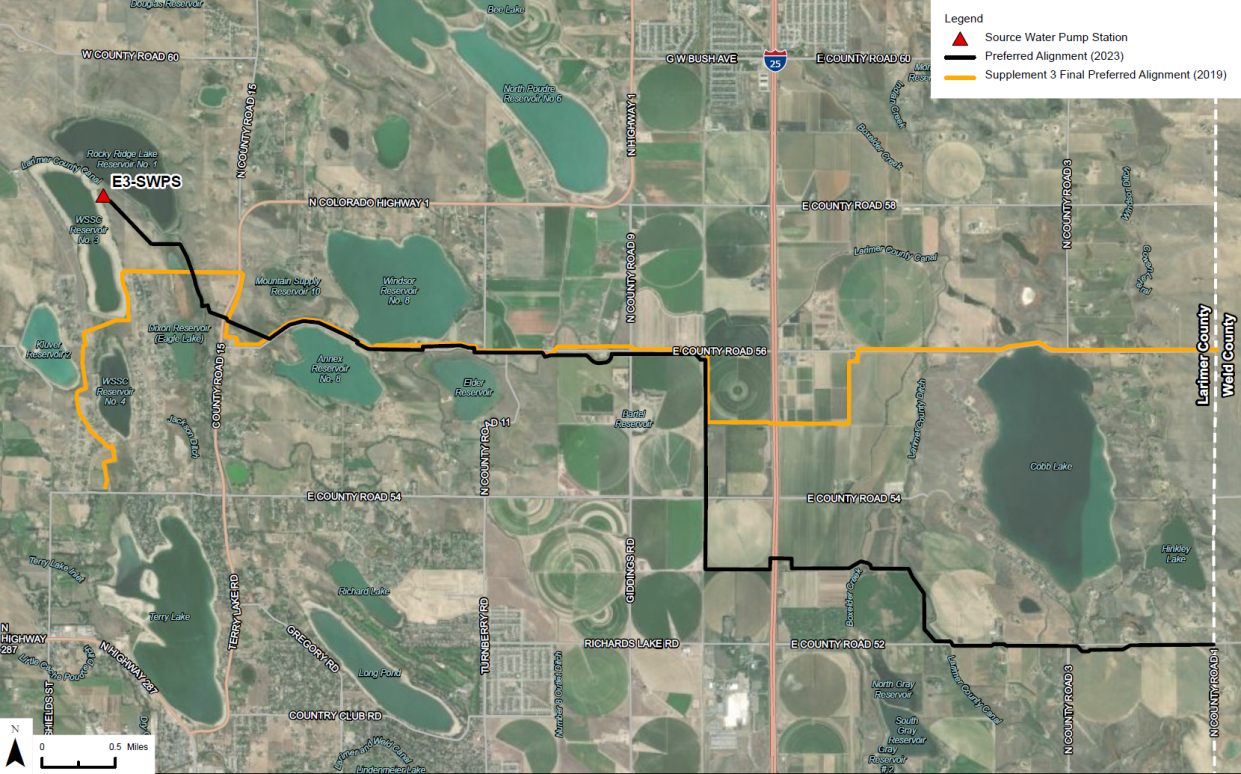Thornton still wants to build water pipeline through Larimer lands: Here are its next steps

The city of Thornton's application to build a water pipeline through Larimer County is ready to move through the formal review process, which includes a chance for public comment.
Thornton's latest application was received last year, and the county had 60 days to review it to make sure it was complete.
Soon, public hearings will be scheduled for the Larimer County Planning Commission and Board of County Commissioners. The dates are unknown now but should be announced no later than March 2, a news release from the county said.
Commissioners will be the ones to decide whether to approve or deny the application.
According to the county's permitting process, Thornton must satisfactorily demonstrate that the project complies with all of the applicable criteria in the land use code. But if not, commissioners can impose "reasonable conditions" to bring the project into compliance with the criteria.
Commissioners also have the right to delay a hearing or discussion if they feel that sufficient information has not been given to show whether the criteria have been met.
Other water news: Ex-landowner sells 90 shares of Colorado-Big Thompson water at auction
This is Thornton's second attempt at an application to build the pipeline, which would carry Poudre River water from reservoirs north of Fort Collins through Larimer, Weld and Adams counties to a water treatment plant in Thornton to support the city's growing population.
The water rights come from farmland Thornton purchased in Larimer and Weld counties in the 1980s.
The city's first application to build the pipeline was filed in 2018 and denied in 2019 by commissioners, who said the project failed to meet seven of the 12 criteria set out in the 1041 permit application process.
During that time, some residents of Larimer County organized the group No Pipe Dream to oppose the project.
Thornton eventually sued the county over its decision, but a state appeals court in 2022 upheld a lower-court decision that favored the county. Thornton then chose not to appeal to the Colorado Supreme Court.
Since the last application, the county's 1041 rules have been revised.
At least seven miles of the 70-mile project have already been built outside of Larimer County, Thornton has said.
What's different this time around: Thornton submits new application for water pipeline in Larimer County.
What happens next in the Thornton pipeline review process?
Staff reviews the application.
The Planning Commission holds a hearing.
The Board of County Commissioners holds as hearing.
Commissioners make a decision.
If a 1041 permit is granted, the project may be required to submit more detailed design, engineering and construction information. Public hearings are not required for this.
Larimer County's 1041 permit requirements
The review of Thornton's application falls under the 1041 permitting process. The criteria for that can be found in Article 10, Sections 9 and 10 of the county land use code.
Those requirements were last updated in 2022.
You can learn more about the 1041 process at www.larimer.gov/planning/1041-regulations.
What do the requirements say Thornton must do?
The requirements say that the project must:
Mitigate impacts to others' properties.
Be consistent with intergovernmental agreements affecting land use and development.
Consider reasonable siting and design alternatives or show why those alternatives are not available or not feasible.
Be technically and financially feasible.
Mitigate impacts to the environment and natural resources, and not significantly degrade the environment or natural resources, or exacerbate or worsen climate change.
Demonstrate how it mitigates impacts on rivers, streams and wetlands to the greatest extent possible.
Not result in unreasonable risk of releases of or exposure to hazardous materials.
Not have a significant adverse effect on adjacent existing land use and development patterns, such as neighborhoods or rural development, or adjacent natural resources.
Not have significant impact on natural resources of statewide importance, including critical habitat for threatened and endangered species.
Not adversely affect any sites and structures listed on the State or National Registers of Historic Places, among others.
Not significantly impact public health and safety.
Not be at risk of significant damage or harm from natural hazards like floods, wildfire, or geologic hazards.
Provide adequate public facilities and services, including sufficiency of water supplies and wastewater treatment capacity.
Not have a significant adverse effect on the capability of local government to provide services or exceed the capacity of service delivery systems.
Not significantly degrade any current or foreseeable future sector of the local economy.
Not unduly degrade the quality or quantity of recreational opportunities and experience.
Reflect principles of resource stewardship and conservation.
Not interfere with certain public views, or else mitigate them.
Mitigate construction impacts to county roads, bridges, and related facilities.
Show that the benefits of the project outweigh the losses of any natural resources or reduction of productivity of agricultural lands.
Demonstrate that the costs to mitigate are proportional to the benefits achieved from the mitigation.
Address recommendations of staff and referral agencies, to the satisfaction of the county commissioners.
Water projects also must meet these criteria:
To the extent practicable, domestic water and wastewater treatment systems shall be consolidated with existing facilities within the area.
The project will not result in duplicative services within the county.
The project will be constructed in areas that will result in the proper utilization of existing treatment plants and the orderly development of domestic water and sewage treatment systems of adjacent communities.
The project emphasizes the efficient use of water.
The applicant shall demonstrate sufficient managerial expertise and capacity to operate the facility.
Major extensions of domestic water and sewage treatment systems shall be permitted in those areas in which the anticipated growth and development that may occur as a result of such extension can be accommodated within the financial and environmental capacity of the area to sustain such growth and development.
This article originally appeared on Fort Collins Coloradoan: Thornton pipeline review begins again in Larimer County

